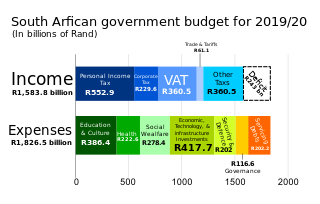
The historical cost of an asset at the time it is acquired or created is the value of the costs incurred in acquiring or creating the asset, comprising the consideration paid to acquire or create the asset plus transaction costs. Historical cost accounting involves reporting assets and liabilities at their historical costs, which are not updated for changes in the items' values. Consequently, the amounts reported for these balance sheet items often differ from their current economic or market values.

Actuarial science is the discipline that applies mathematical and statistical methods to assess risk in insurance, pension, finance, investment and other industries and professions. More generally, actuaries apply rigorous mathematics to model matters of uncertainty and life expectancy.
An expense is an item requiring an outflow of money, or any form of fortune in general, to another person or group as payment for an item, service, or other category of costs. For a tenant, rent is an expense. For students or parents, tuition is an expense. Buying food, clothing, furniture, or an automobile is often referred to as an expense. An expense is a cost that is "paid" or "remitted", usually in exchange for something of value. Something that seems to cost a great deal is "expensive". Something that seems to cost little is "inexpensive". "Expenses of the table" are expenses for dining, refreshments, a feast, etc.
This aims to be a complete list of the articles on real estate.
A homeowner association, or a homeowner community, is a private association-like entity in the United States, Canada, and certain other countries often formed either ipso jure in a building with multiple owner-occupancies, or by a real estate developer for the purpose of marketing, managing, and selling homes and lots in a residential subdivision. The developer will typically transfer control of the association to the homeowners after selling a predetermined number of lots.

An income statement or profit and loss account is one of the financial statements of a company and shows the company's revenues and expenses during a particular period.

A condominium is an ownership regime in which a building is divided into multiple units that are either each separately owned, or owned in common with exclusive rights of occupation by individual owners. These individual units are surrounded by common areas that are jointly owned and managed by the owners of the units. The term can be applied to the building or complex itself, and is sometimes applied to individual units. The term "condominium" is mostly used in the US and Canada, but similar arrangements are used in many other countries under different names.

Capital expenditure or capital expense is the money an organization or corporate entity spends to buy, maintain, or improve its fixed assets, such as buildings, vehicles, equipment, or land. It is considered a capital expenditure when the asset is newly purchased or when money is used towards extending the useful life of an existing asset, such as repairing the roof.
Closing costs are fees paid at the closing of a real estate transaction. This point in time called the closing is when the title to the property is conveyed (transferred) to the buyer. Closing costs are incurred by either the buyer or the seller.
The term replacement cost or replacement value refers to the amount that an entity would have to pay to replace an asset at the present time, according to its current worth.
Cash out refinancing occurs when a loan is taken out on property already owned, and the loan amount is above and beyond the cost of transaction, payoff of existing liens, and related expenses.

Fund accounting is an accounting system for recording resources whose use has been limited by the donor, grant authority, governing agency, or other individuals or organisations or by law. It emphasizes accountability rather than profitability, and is used by Nonprofit organizations and by governments. In this method, a fund consists of a self-balancing set of accounts and each are reported as either unrestricted, temporarily restricted or permanently restricted based on the provider-imposed restrictions.
A reserve study is a long-term capital budget planning tool which identifies the current status of the reserve fund and a stable and equitable funding plan to offset ongoing deterioration, resulting in sufficient funds when those anticipated major common area expenditures actually occur. The reserve study consists of two parts: the physical analysis and the financial analysis. This document is often prepared by an outside independent consultant for the benefit of administrators of a property with multiple owners, such as a condominium association or homeowners' association (HOA), strata, containing an assessment of the state of the commonly owned property components as determined by the particular association's covenants, conditions, and restrictions (CC&Rs) and bylaws. Reserve studies however are not limited only to condominiums and can be created for any "common interest community" (CIC) properties such as resort properties, community/neighborhood associations, coops, etc.
The Emergency Economic Stabilization Act of 2008, often called the "bank bailout of 2008" or the "Wall Street bailout", was proposed by Treasury Secretary Henry Paulson, passed by the 110th United States Congress, and signed into law by President George W. Bush. It became law as part of Public Law 110-343 on October 3, 2008, in the midst of the financial crisis of 2007–2008. It created the $700 billion Troubled Asset Relief Program (TARP) to purchase toxic assets from banks. The funds were mostly redirected to inject capital into banks and other financial institutions while the Treasury continued to examine the usefulness of targeted asset purchases.
The Davis–Stirling Common Interest Development Act is the popular name of the portion of the California Civil Code beginning with section 4000, which governs condominium, cooperative, and planned unit development communities in California. Contrary to what the title of the Act suggests, the bill was authored/drafted by University of San Diego School of Law Professor Katharine N. Rosenberry while she served as a Senior Consultant to the California Assembly Select Committee on Common Interest Developments. Assemblymen Lawrence W. "Larry" Stirling and Gray Davis added their names as authors prior to the bill being passed/enacted by the California State Legislature in September 1985. In 2012, the Act was comprehensively reorganized and recodified by Assembly Bill 805.

East Garrison is a planned community in an unincorporated area in Monterey County, California. It is located on Reservation Road east of Marina and west of the Salinas River on the former Fort Ord. The community has 929 taxed parcels. The community contains many parks including dog parks, the 5-acre Lincoln Park with sports field as well as West Camp Park, McArthur Park, Arts Park which are approximately one acre each. East Garrison is part of Monterey County's Fourth District and, as of January 5, 2021, is represented by Supervisor Wendy Root Askew.
Strata management, sometimes known as "body corporate management", is a specialist area of property management involving the day-to-day operation and management of a property that is jointly owned and comprises multiple units, common areas and common facilities. It is derived from an Australian concept of property law called strata title applied to the administration of common ownership in apartment buildings on multiple levels, or strata. Emerging markets in Dubai, Abu Dhabi, the Philippines and India have adopted the Australian system. It is one of the fastest growing forms of housing in the United States today, similar to common-interest development (CID), a category that includes planned unit developments of single-family homes, known as homeowner associations (HOAs), condominiums, and cooperative apartments. Federally-subsidized financing provided by two government-sponsored enterprises Fannie Mae and Freddie Mac via uniform financial instruments—mortgages that oblige the borrower to honour covenant restrictions of the collective-property regime with PUD or condo riders. Such provisions however are only enforceable where statutes recognise their validity. Common expense liabilities are often subordinated as junior liens in bankruptcy courts, with the bank retaining senior title.

Common-interest development (CID) is the fastest growing form of housing in the world today. They include condominiums, community apartments, planned developments, and stock cooperatives. A CID's ownership benefits are having rights to an undivided interest in common areas and amenities that might prove to be too expensive to be solely owned. For example, an owner would like to have a pool but cannot afford one. When buying a condominium with a pool in a CID of one hundred units, an owner would have use of that pool for basically one-hundredth of the cost due to sharing the cost with the other 99 owners. Timeshare, or vacation ownership, is the same concept. Buying a second home for vacation purposes might not be financially possible; buying a week or two can be when sharing the overall costs with other participants.

Taxation may involve payments to a minimum of two different levels of government: central government through SARS or to local government. Prior to 2001 the South African tax system was "source-based", where in income is taxed in the country where it originates. Since January 2001, the tax system was changed to "residence-based" wherein taxpayers residing in South Africa are taxed on their income irrespective of its source. Non residents are only subject to domestic taxes.
The HERO Program is an energy efficient financing program in the United States. The name HERO stands for Home Energy Renovation Opportunity. The HERO Program is a Property Assessed Clean Energy (PACE) Program, which provides financing for energy-efficient, water-efficient and renewable energy products to home and business owners in approved communities within California and Missouri. The financing provided by the HERO Program is repaid through annual property tax payments, which are collected by the county and in some cases may be passed on to a new property owner if the property is sold.






